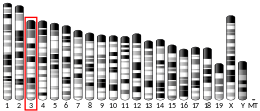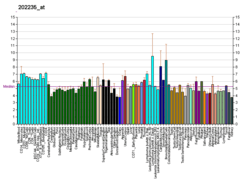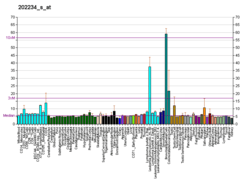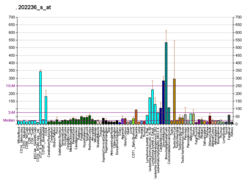Monocarboxylate transporter 1
Monocarboxylate transporter 1 is a protein that in humans is encoded by the SLC16A1 gene (also known as MCT1).[5][6][7] It is a proton coupled monocarboxylate transporter.
Biochemistry
Detailed kinetic analysis of monocarboxylate transport in erythrocytes revealed that MCT1 operates through an ordered mechanism. MCT1 has a substrate binding site open to the extracellular matrix which binds a proton first followed by the lactate anion. The protein then undergoes a conformational change to a new ‘closed’’ conformation that exposes both the proton and lactate to the opposite surface of the membrane where they are released, lactate first and then the proton. For net transport of lactic acid, the rate-limiting step is the return of MCT1 without bound substrate to the open conformation. For this reason, exchange of one monocarboxylate inside the cell with another outside is considerably faster than net transport of a monocarboxylate across the membrane.
Animal studies
Overexpression of MCT1 has been shown to increase the efficacy of an anti-cancer drug currently undergoing clinical trials called 3-bromopyruvate in breast cancer cells.[8]
Clinical significance
Most cases of alveolar soft part sarcoma show PAS(+), diastase-resistant (PAS-D (+)) intracytoplasmic crystals which contain CD147 and monocarboxylate transporter 1 (MCT1).[9] Overexpression of MCT1 in pancreatic beta cells leads to hyperinsulinism during exercise.[10]
See also
References
- ENSG00000281917 GRCh38: Ensembl release 89: ENSG00000155380, ENSG00000281917 - Ensembl, May 2017
- GRCm38: Ensembl release 89: ENSMUSG00000032902 - Ensembl, May 2017
- "Human PubMed Reference:". National Center for Biotechnology Information, U.S. National Library of Medicine.
- "Mouse PubMed Reference:". National Center for Biotechnology Information, U.S. National Library of Medicine.
- Garcia CK, Goldstein JL, Pathak RK, Anderson RG, Brown MS (Mar 1994). "Molecular characterization of a membrane transporter for lactate, pyruvate, and other monocarboxylates: implications for the Cori cycle". Cell. 76 (5): 865–73. doi:10.1016/0092-8674(94)90361-1. PMID 8124722.
- Garcia CK, Li X, Luna J, Francke U (Sep 1994). "cDNA cloning of the human monocarboxylate transporter 1 and chromosomal localization of the SLC16A1 locus to 1p13.2-p12". Genomics. 23 (2): 500–3. doi:10.1006/geno.1994.1532. PMID 7835905.
- "Entrez Gene: SLC16A1 solute carrier family 16, member 1 (monocarboxylic acid transporter 1)".
- Liu Z, Sun Y, Hong H, Zhao S, Zou X, Ma R, Jiang C, Wang Z, Li H, Liu H (2015-08-15). "3-bromopyruvate enhanced daunorubicin-induced cytotoxicity involved in monocarboxylate transporter 1 in breast cancer cells". American Journal of Cancer Research. 5 (9): 2673–85. PMC 4633897. PMID 26609475.
- Ladanyi M, Antonescu CR, Drobnjak M, Baren A, Lui MY, Golde DW, Cordon-Cardo C (Apr 2002). "The precrystalline cytoplasmic granules of alveolar soft part sarcoma contain monocarboxylate transporter 1 and CD147". The American Journal of Pathology. 160 (4): 1215–21. doi:10.1016/S0002-9440(10)62548-5. PMC 1867200. PMID 11943706.
- Pullen TJ, Sylow L, Sun G, Halestrap AP, Richter EA, Rutter GA (Jul 2012). "Overexpression of monocarboxylate transporter-1 (SLC16A1) in mouse pancreatic β-cells leads to relative hyperinsulinism during exercise". Diabetes. 61 (7): 1719–25. doi:10.2337/db11-1531. PMC 3379650. PMID 22522610.
Further reading
- Bonen A (Nov 2001). "The expression of lactate transporters (MCT1 and MCT4) in heart and muscle". European Journal of Applied Physiology. 86 (1): 6–11. doi:10.1007/s004210100516. PMID 11820324.
- Halestrap AP, Meredith D (Feb 2004). "The SLC16 gene family-from monocarboxylate transporters (MCTs) to aromatic amino acid transporters and beyond". Pflügers Archiv : European Journal of Physiology. 447 (5): 619–28. doi:10.1007/s00424-003-1067-2. PMID 12739169.
- Kim CM, Goldstein JL, Brown MS (Nov 1992). "cDNA cloning of MEV, a mutant protein that facilitates cellular uptake of mevalonate, and identification of the point mutation responsible for its gain of function". The Journal of Biological Chemistry. 267 (32): 23113–21. PMID 1429658.
- Bonaldo MF, Lennon G, Soares MB (Sep 1996). "Normalization and subtraction: two approaches to facilitate gene discovery". Genome Research. 6 (9): 791–806. doi:10.1101/gr.6.9.791. PMID 8889548.
- Ritzhaupt A, Wood IS, Ellis A, Hosie KB, Shirazi-Beechey SP (Dec 1998). "Identification and characterization of a monocarboxylate transporter (MCT1) in pig and human colon: its potential to transport L-lactate as well as butyrate". The Journal of Physiology. 513 (Pt 3): 719–32. doi:10.1111/j.1469-7793.1998.719ba.x. PMC 2231331. PMID 9824713.
- Rahman B, Schneider HP, Bröer A, Deitmer JW, Bröer S (Aug 1999). "Helix 8 and helix 10 are involved in substrate recognition in the rat monocarboxylate transporter MCT1". Biochemistry. 38 (35): 11577–84. doi:10.1021/bi990973f. PMID 10471310.
- Brooks GA, Brown MA, Butz CE, Sicurello JP, Dubouchaud H (Nov 1999). "Cardiac and skeletal muscle mitochondria have a monocarboxylate transporter MCT1". Journal of Applied Physiology. 87 (5): 1713–8. doi:10.1152/jappl.1999.87.5.1713. PMID 10562613.
- Merezhinskaya N, Fishbein WN, Davis JI, Foellmer JW (Jan 2000). "Mutations in MCT1 cDNA in patients with symptomatic deficiency in lactate transport". Muscle & Nerve. 23 (1): 90–7. doi:10.1002/(SICI)1097-4598(200001)23:1<90::AID-MUS12>3.0.CO;2-M. PMID 10590411.
- Kirk P, Wilson MC, Heddle C, Brown MH, Barclay AN, Halestrap AP (Aug 2000). "CD147 is tightly associated with lactate transporters MCT1 and MCT4 and facilitates their cell surface expression". The EMBO Journal. 19 (15): 3896–904. doi:10.1093/emboj/19.15.3896. PMC 306613. PMID 10921872.
- Cuff MA, Lambert DW, Shirazi-Beechey SP (Mar 2002). "Substrate-induced regulation of the human colonic monocarboxylate transporter, MCT1". The Journal of Physiology. 539 (Pt 2): 361–71. doi:10.1113/jphysiol.2001.014241. PMC 2290148. PMID 11882670.
- Cuff MA, Shirazi-Beechey SP (Apr 2002). "The human monocarboxylate transporter, MCT1: genomic organization and promoter analysis". Biochemical and Biophysical Research Communications. 292 (4): 1048–56. doi:10.1006/bbrc.2002.6763. PMID 11944921.
- Lambert DW, Wood IS, Ellis A, Shirazi-Beechey SP (Apr 2002). "Molecular changes in the expression of human colonic nutrient transporters during the transition from normality to malignancy". British Journal of Cancer. 86 (8): 1262–9. doi:10.1038/sj.bjc.6600264. PMC 2375337. PMID 11953883.
- Zhang GZ, Huang GJ, Li WL, Wu GM, Qian GS (Jul 2002). "[Effect of co-inhibition of MCT1 gene and NHE1 gene on proliferation and growth of human lung adenocarcinoma cells]". AI Zheng = Aizheng = Chinese Journal of Cancer. 21 (7): 719–23. PMID 12479094.
- Philp NJ, Wang D, Yoon H, Hjelmeland LM (Apr 2003). "Polarized expression of monocarboxylate transporters in human retinal pigment epithelium and ARPE-19 cells". Investigative Ophthalmology & Visual Science. 44 (4): 1716–21. doi:10.1167/iovs.02-0287. PMID 12657613.
- Asada K, Miyamoto K, Fukutomi T, Tsuda H, Yagi Y, Wakazono K, Oishi S, Fukui H, Sugimura T, Ushijima T (2003). "Reduced expression of GNA11 and silencing of MCT1 in human breast cancers". Oncology. 64 (4): 380–8. doi:10.1159/000070297. PMID 12759536.






